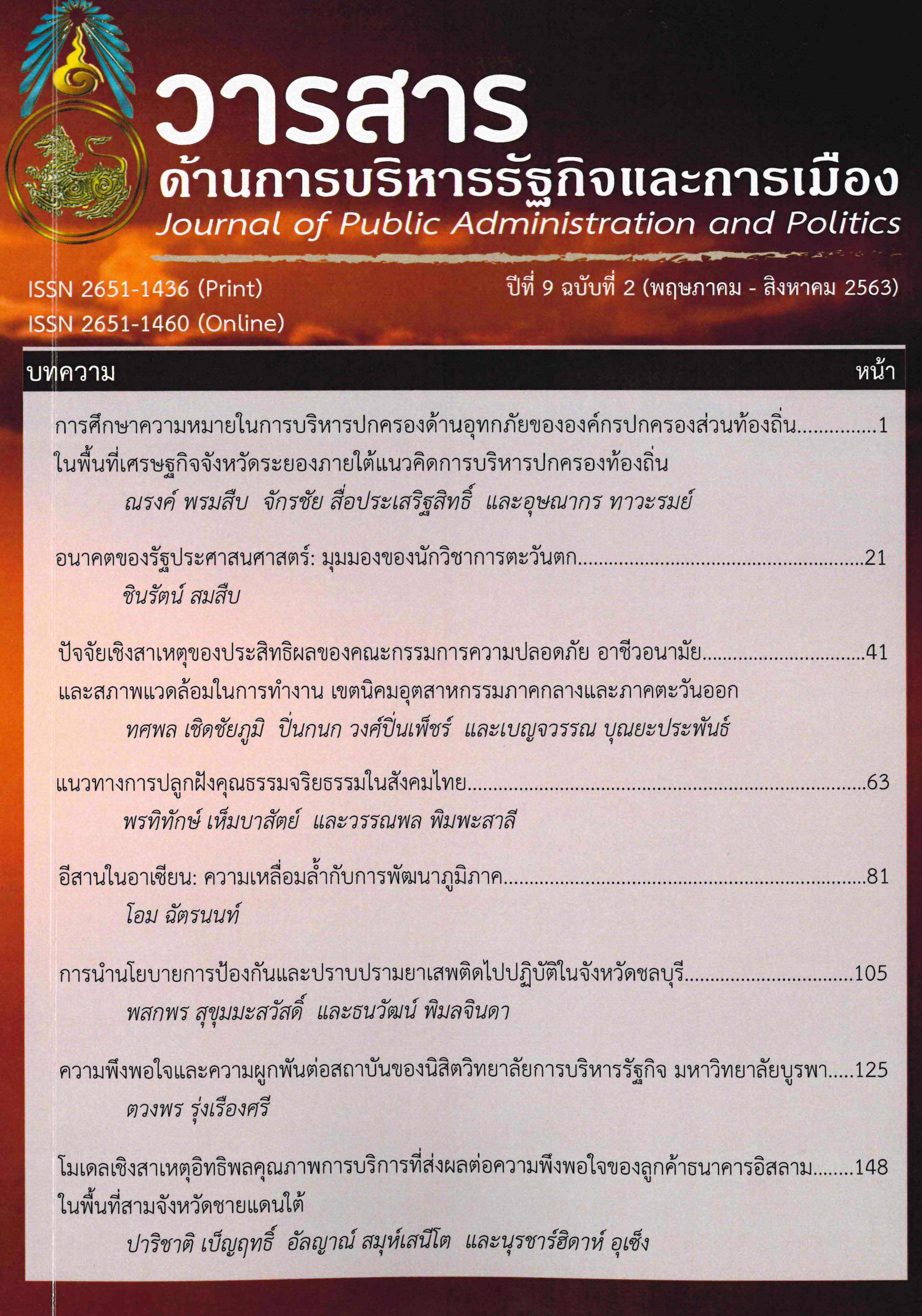โมเดลเชิงสาเหตุอิทธิพลคุณภาพการบริการที่ส่งผลต่อความพึงพอใจของลูกค้าธนาคารอิสลามในพื้นที่สามจังหวัดชายแดนภาคใต้
Main Article Content
บทคัดย่อ
ภายใต้การแข่งขันของธุรกิจของสถาบันการเงินที่มีความทวีรุนแรงมากยิ่งขึ้นในประเทศไทย ทำให้ผู้บริหารธนาคารต้องกลับมาให้สำคัญกับความพึงพอใจของลูกค้ามากขึ้น ซึ่งจะส่งผลต่อประสิทธิภาพของการประกอบการ กำไร และความอยู่รอดอย่างยั่งยืนของธนาคาร ดังนั้นการศึกษานี้มีวัตถุประสงค์เพื่อศึกษาระดับความพึงพอใจในใช้บริการธนาคารอิสลามลูกค้าธนาคารอิสลามในสามจังหวัดชายแดนภาคใต้ พร้อมด้วยศึกษาปัจจัยคุณภาพการบริการที่มีอิทธิพลต่อความพึงพอใจ ซึ่งประกอบด้วย 6 ด้าน ได้แก่ ด้านลักษณะทางกายภาพในการให้บริการ ด้านความน่าเชื่อถือของธนาคาร ด้านการตอบสนองต่อความต้องการ ด้านความเชื่อมั่น ด้านการเอาใจใส่ และด้านการปฏิบัติตามหลักการอิสลาม
แบบสอบถามที่สอดคล้องกับวัตถุประสงค์ถูกสร้างขึ้นมาเพื่อเป็นเครื่องมือในการวิจัย กลุ่มตัวอย่างในการศึกษาคือ ลูกค้าของธนาคารอิสลามในสามจังหวัดชายแดนภาคใต้ จำนวน 402 ราย ใช้โปรแกรมสำเร็จรูป SPSS และ Smart PLS ในการวิเคราะห์ข้อมูล ผลการศึกษาระดับความพึงพอใจของลูกค้าธนาคารอิสลามในสามจังหวัดชายแดนภาคใต้พบว่าอยู่ในระดับมาก สำหรับผลวิเคราะห์คุณภาพการบริการที่มีอิทธิพลต่อความพึงพอใจแสดงให้เห็นว่า คุณภาพการบริการด้านการตอบสนองต่อความต้องการมีอิทธิพลเชิงบวกอย่างมีนัยสำคัญต่อความพึงพอใจในการใช้บริการของธนาคารอิสลามมากที่สุด ตามมาด้วย ด้านการเอาใจใส่ ด้านการปฏิบัติตามหลักการอิสลาม ด้านความเชื่อมั่น และด้านลักษณะทางกายภาพในการให้บริการ ตามลำดับ ในขณะที่ด้านความน่าเชื่อถือของธนาคารพบว่า ไม่มีอิทธิพลต่อความพึงพอใจในการใช้บริการของธนาคารอิสลาม
Article Details
เอกสารอ้างอิง
- กาญจนา บุญชม (2558). การเปรียบเทียบมาตรฐานการดำเนินงานของสถาบันการเงินอิสลามของประเทศไทยกับประเทศมาเลเซีย.
สุทธิปริทัศน์, 29(92), หน้า 52-64.
- ธนาคารอิสลามแห่งประเทศไทย. (2562). ประวัติธนาคาร. สืบค้นเมื่อ ตุลาคม 25, 2562, จาก https://sites.google.com/
site/itaiifa5720410081
- อรุณ บุญชม. (2557). ระบบธนาคารอิสลามเทียบกับระบบธนาคารพาณิชย์. สืบค้นเมื่อ กันยายน 5, 2562, จากhttp://www.skthai.org/articles/41956486
- Abdullah, D. V., & Chee, K. (2013). Islamic finance: Why it makes sense (For you): Understanding its principles and practices (2nd ed.). Singapore: Marshall Cavendish Business.
- Ali, M., & Raza, S. A. (2017). Service quality perception and customer satisfaction in Islamic Banks of Pakistan: The modified SERVQUAL model. Total Quality Management and Business Excellence, 28(5-6), pp. 559-577.
- Amin, M., & Isa, Z. (2008). An examination of the relationship between service quality perception and customer satisfaction: A SEM approach towards Malaysian Islamic banking. International Journal of Islamic and Middle Eastern Finance and Management, 1(3), pp. 191-209.
- Armstrong, G., & Kotlor, P. (Eds.). (2013). Marketing an introduction (11st ed.). England: Pearson Education.
- Caru, A., & Cugini, A. (1999). Profitability and customer satisfaction in services. International Journal of Service Industry Management, 10(2), pp. 132–157.
- Cochran, W. G. (1977). Sampling techniques. New York: John Wiley and Sons.
- Cronin. Jr, J., & Taylor, S. (1992). Measuring service quality: A re-examination and extension. Journal of Marketing, 56(3), pp. 55-68.
- Culiberg, B., & Rojšek, I. (2010). Identifying service quality dimensions as antecedents to customer satisfaction in retail banking. Economic and Business Review, 12(3), pp. 151-166.
- Grönroos, C. (1984). A service quality model and its marketing implications. European Journal of Marketing, 18(4), pp. 36-44.
- Hair, J. F., Hult, G. T. M., Ringle, C. M., Sarstedt, M. (2013). A Primer on partial least squares structural equation modeling (PLS-SEM). Thousand Oaks: Sage.
- Hammoud, N., & Bittar, M. (2016), Measuring the quality of Islamic Banks' services and its impact on customers' satisfaction "a survey study on the Islamic Banks' customers in Lattakia -Syria". International Journal of Business,
Economics and Management, 3(1), pp. 1-17.
- Johnson, M. D., Anderson, E. W., & Fornell, C. (1995). Rational and adaptive performance expectations in a customer satisfaction framework. Journal of Consumer Research, 21(4), pp. 695-707.
- Khan, M. M., & Fasih, M. (2014). Impact of service quality on customer satisfaction and customer loyalty: Evidence from banking sector. Pakistan Journal of Commerce and Social Sciences, 8(2), pp. 331-354.
- Khurana, S. (2013). Service quality versus customer satisfaction in banking sector: A literature review. The IUP Journal of Marketing Management, 12(4), pp. 65-78.
- Levesque, T. & McDougall, G. H. G. (1996). Determinants of customer satisfaction in retail banking. The International Journal of Bank Marketing, 14(7), pp. 12-20.
- Malhotra, N., Francis, M. U., James, A., Shainesh, G., & Wu, L. (2005), Dimensions of service quality in developed and developing economies: Multi-country cross-cultural comparisons. International Marketing Review, 22(3), pp. 256-278.
- Maswadeh, S. N. (2015). An evaluation of SMEs satisfaction toward Jordanian Islamic Banks Service Quality. Procedia Economics and Finance, 23, pp. 86-94.
- Muhammad Awan, H., Shahzad, K.,& Iqbal, A. (2011). Service quality and customer satisfaction in the banking sector: A comparative study of conventional and Islamic Banks in Pakistan. Journal of Islamic Marketing, 2(3), pp. 203-224.
- Parasuraman, A., Zeithaml, V. A., & Berry, L. L. (1988). SERVQUAL: A multiple-item scale for measuring consumer perceptions of service quality. Journal of Retailing, 64(1), pp. 12-37.
- Zikmund, W. G., Babin, B. J., Carr, J. C. & Griffin, M. (2013). Business research methods (9th ed.). Canada: South-Western, Cengage Learning.


